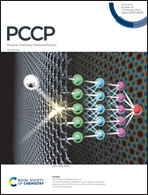Atomistic origins of charge traps in CdSe nanoclusters†
Abstract
Constructing trap-free nanomaterials is a challenge that requires a fundamental understanding of the trapping phenomenon, especially the structural features responsible for electronic localization. Previously, such trapping configurations were explored by manual insertion of surface defects according to researchers' intuition, e.g. Cd–Se–Cd moiety [Houtepen et al., Chem. Mater., 2017, 29, 752]. In this study we report new types of traps in CdSe nanoclusters, including the metal-based one, which were found using a novel, unbiased approach. Namely, we screened a vast number of globally optimized CdnSem clusters (n,m ≤ 15) for localized electronic states. These systems model the wide diversity of defects in unpassivated areas of a nanocluster surface, while still being accessible for ab initio global optimization. Despite this variety, all 39 traps we found fall into 3 types, including two new ones. Such a reduction shows the universal character of discovered traps, irrelevant to the global structure of a cluster. Many of these traps not only have newly reported atomic arrangements, but also original confinement mechanisms which are explained at the atomistic level. We found that the relaxation and global optimization of the cluster structure greatly reduce the number of traps and push the trap energies from midgap to the near-gap edge positions, which agrees with the spectral measurements of II–VI semiconductor nanocrystals.



 Please wait while we load your content...
Please wait while we load your content...